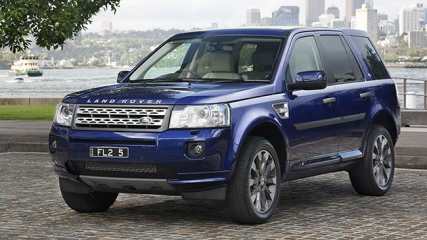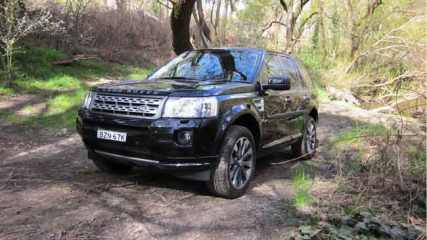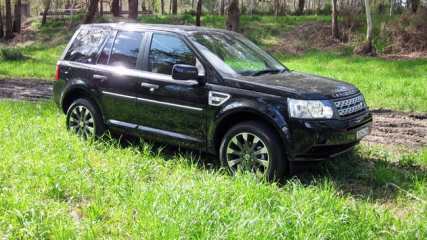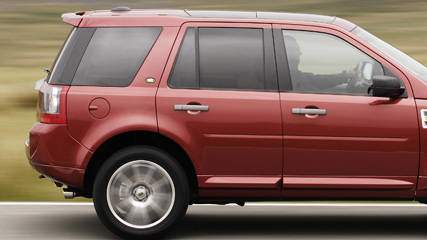2007 Land Rover Freelander Reviews
You'll find all our 2007 Land Rover Freelander reviews right here. 2007 Land Rover Freelander prices range from $3,410 for the Freelander S 4x4 to $6,490 for the Freelander Hse 4x4.
Our reviews offer detailed analysis of the 's features, design, practicality, fuel consumption, engine and transmission, safety, ownership and what it's like to drive.
The most recent reviews sit up the top of the page, but if you're looking for an older model year or shopping for a used car, scroll down to find Land Rover dating back as far as 1998.
Or, if you just want to read the latest news about the Land Rover Freelander, you'll find it all here.

Used Land Rover Freelander review: 1998-2013
Read the article
By Ewan Kennedy · 12 Feb 2014
Though it's generally used only as a suburban runabout, the Land Rover Freelander is capable of tackling bush, beaches and desert conditions that would strand, or even break, others in its class.

Land Rover Freelander TD4 2007 review
Read the article
By Peter Barnwell · 15 Oct 2011
Don't laugh... plenty of people accidentally put petrol in their diesel at the servo and it creates an absolute calamity.This can't happen in the Land Rover Freelander because there's a diesel only nozzle hole on the fuel inlet. It's a simple fix and underlines just how much thought has gone into this impressive compact SUV from Britain.Well, the Britain bit is not totally correct because new Freelander II TD4's engine is from PSA — Peugeot in France and is a 2.2-litre turbodiesel with 110kW/420Nm output. A similar engine is used in the new Peugeot 508 and other vehicles.A water-cooled variable geometry turbo (VGT) is used to optimise efficiency and contributes to the Freelander's impressive 6.6-litres/100km fuel economy.Of course, being a Land Rover means the Freelander will go almost anywhere — and get back and to this end, is fitted with L-R-s clever Terrain Response system. This offers a range of modes to suit various driving environments. It's selected simply by turning a dial on the centre console.It's a full time four wheel drive and is equipped with decent dual purpose tyres that neither hum too loudly on sealed roads nor lose grip too easily on slippery surfaces.As version two of the current shape the new model benefits from evolutionary changes and upgrades not the least to its appearance and standard equipment.The outside has been tweaked to give a family Land Rover look to the front with grille and headlight changes, revised body hardware and similar minor changes to the rear end. It is a positive step because this new Freelander is the best looker so far.They have grown a green conscience at the factory and equip Freelander with an array of technology to cut emissions and reduce fuel consumption such as the smart charging battery that only draws power when the engine is decelerating. It will happily ingest biodiesel and the manual TD4 has engine stop/start.Freelander is impressively quiet inside and the engine has plenty of pull across a wide engine speed range.The test vehicle was a mid-range XS priced at $52,790 but features plenty of luxury kit including leather and a decent locally fitted Garmin satnav system. It has a six-speed auto transmission with adaptive shift and sequential change mode which seem superfluous because it's best left in D.Ride quality is excellent offering a high level of comfort and a degree of sportiness. We took the TD4 off road and it simply toyed with what we threw at it in terms of sand and beach driving, slippery, muddy dirt roads, water crossings and rough rock hopping.On the highway and around town is a similar story — no complaints at all really. It's comfortable, goes extremely well, has all manner of luxuries and looks great.It even got the big thumbs up from "The Boss," who was reluctant to hand over the keys. And you can't get a better recommendation than that....

Land Rover Freelander 2007 review
Read the article
By Stuart Martin · 12 Oct 2011
If a car brand completely resists trends and change, there's every chance it won't live to regret the decision. Land Rover - like Jeep in many ways - resisted the soft-roader trend, preferring to keep things like dual range, ground clearance and off-road ability before indulging in metrosexual tendencies.Both hard-core 4WD brands succumbed and Land Rover's result was the Freelander, which is without a transfer case and sits lower than the rest of the Land Rover range - but don't mistake it for an overgrown shopping trolley built for the school run and nothing else.We're in the range-topping SD4 HSE - which has a lofty $65,854 asking price before any stickers are added or taxes paid. That's not cheap'n'cheerful, but patience - the contents list includes satellite navigation, steering wheel controls for audio, cruise and phone, dual zone climate control, manual reach and rake steering adjustment, power-adjustable front seats with armrests, automatic xenon headlights, parking sensors front and rear (but no rear camera), Bluetooth phone link, leather trim for the seats, steering wheel, gearshifter and console, trip computer, dual-zone climate control, automatic headlights and windscreen wipers.The test car was also packing gear from the HSE Premium Luxury package, which adds $6890 to the bottom line and among its inclusions are adaptive function for the headlights, 19in 10-spoke diamond cut alloy wheels (including a full-size spare), an auto-dimming rearvision mirror, heating for the front seats, a heated front windscreen (for the snow bunnies), upgraded leather trim and the Alpine 13-speaker surround sound system. The option box for the double sunroof (for $3300) and black metallic paint (a $1700 hit) were also ticked, taking the as-tested priced to a grand total of $78,144.The little Landie packs plenty of good stuff, although this particular engine misses out on the start-stop fuel saving system found elsewhere in the range, there's brake energy recovery to keep the battery charged up.The 2.2-litre turbodiesel is a common-rail unit that employs balance shafts to keep it smooth - Land Rover's own figures suggest it is one decibel quieter than the in-line six-cylinder petrol. The powerplant produces 140kW at 3500rpm, which is not too far short of the petrol engine's 171kW effort. The diesel has a peak torque figure of 420Nm and a combined fuel consumption claim of 7 litres per 100km, 103Nm more than the petrol engine and using 3.7 fewer litres per 100km. The Freelander sips from a 68-litre tank, suggesting an open-road touring range of 1000km would be possible.Where the Freelander has an advantage over much of its compact SUV competition is the Terrain Response drivetrain system that tailors the car's electronic systems to the impending terrain.Although not as advanced as the Terrain Response in its larger brethren - in the case of the Range Rover Sport now has a dynamic driving mode for the active suspension - the Freelander has four modes - general driving, grass/gravel/snow, mud/ruts and sand - for getting it a little bit dirty.The stability and traction control systems, as well as the Haldex four-wheel drive system, work together to endow the Freelander with a level of offroad ability well beyond the segment average. The drivetrain uses an electronically-controlled rear diff to put drive to the rear wheels as required, via a six-speed automatic transmission, as well as a hill-start and downhill assistance systems.It's not quite a mini Disco or Defender, nor is it a pint-sized Rangie (they've done that now anyway) but the Freelander has aspects of all three - the front grille in particular - within its fairly conventional exterior package. That's far from a bad thing as the Land Rover breed has always produced handsome machinery, from the rugged utilitarian 110 and Defender models through the to the regal and arrogant supremacy exuded by the Range Rover.The cabin follows suit, adopting (as you'd expect) switchgear and dash layouts from the rest of the family. The test car's burnt orange interior might not be the first choice in trim colour but the ergonomics of the interior are much-improved over earlier Land Rover product - the only way in many cases was up.Aside from the inherent active safety of all-wheel drive, the Freelander employs anti-lock brakes with emergency braking assistance (which the company says can reduce stopping distances by up to 15 per cent) and brakeforce distribution systems. Some of the same hardware also deploys in the form of traction and stability control, as well as cornering braking and anti-rollover control systems. The passive safety features list includes dual front, front-side airbags and full-length side-curtain airbags, as well as a driver's knee airbag.This segment is awash with vehicles that have no chance of overcoming a wet grassy slope at a country footy game - the Freelander is not one of those soft-roader wanna-bes. The green oval badge would (I hope) fall off in disgust if it weren't capable of getting its Continental rubber grotty and ploughing on unfazed. Granted, it's never going to clamber over the terrain its brethren can, but it will certainly complete more arduous tasks than the bulk of its competitive set.Terrain Response is off-roading for dunces and - provided you have faith in the under-body protection - it can be bumped and thumped over some more challenging terrain. Tracks violated by big ruts left by large off-roaders will offer the Freelander a challenge only through lack of clearance, which is decent for the segment at 210mm, not from a lack of tractive performance from the drivetrain. On the bitumen, the Freelander is a very comfortable conveyance - the top-spec leather seats are well-cushioned (if not heavily endowed with lateral support).Ride comfort is more supple than the German prestige competitors and while body roll is a little more prevalent, it's not a roly-poly mess like the original Range Rovers - it progresses with purpose once settled into a bend.The driver has enough adjustment to get a good position behind the wheel and rear seat head and leg space is still reasonable with taller occupants in the front.The diesel is reasonably quiet and offers a solid shove in the back from low in the rev range, without having to resort to full throttle - punch it hard and Land Rover says it will hit 190km/h and only takes 9.5 seconds to hit 100km/h, which is not far off the petrol six-cylinder model's claim.In cabin storage is reasonably good but the level of connectivity isn't up to par - no USB socket or Bluetooth link for the music, just a 3.5mm jack.There are cheaper prestige alternatives in this segment - as well as a well-mannered local - but what price to pay for the compact SUV with badge cred? It is probably top of the pops in off-road terms and pretty good on the bitumen too, but the high asking price takes the shine from the Freelander.

Land Rover Freelander HSE 2007 review
Read the article
By Neil McDonald · 14 Aug 2007
In a quiet moment, even Land Rover admits the Freelander has gone from sinner to sainthood. The previous model, which was a hit in Europe but a lowly performer locally, was even nicknamed the “Freeloader” by many road-testers.The previous generation's respectable heritage was shattered by poor build quality, questionable reliability and lacklustre engines. Local buyers were aware of this and gave it a wide berth. Last year Land Rover sold 87 and in 2005 only 145 for the year.This time around though, the British company with a royal warrant and seriously chic Range Rover has got it right. Land Rover Australia says the Freelander is the most complete in its class and can justifiably take its place against the BMW X3 and Lexus RX330.Two petrol and two turbo-diesels are available. The petrol line-up is priced from $49,990 for the six-cylinder Si6 SE and $55,990 for the Si6 HSE. The Td4 SE and HSE models add $2000. Options include a $6890 “tech pack” with Bluetooth, satellite navigation and xenon adaptive headlights, $1500 for metallic paint and $3300 for a sunroof.The slick 3.2-litre in-line six is shared with Volvo but built by Land Rover and the punchy 2.2-litre Td4 comes from the French PSA Group. Both engines are mated to a smooth-shifting Aisin six-speed sequential automatic.The Si6 delivers a healthy 171kW at 6300 revs and 317Nm at 3200 revs. This is 30 per cent more than the old V6 and a 10 per cent improvement in fuel economy. The 2.2-litre Td4 ups the ante in the torque stakes, with 400Nm on tap at 2000 revs. This is significantly better than the 260Nm delivered by the old 2.0-litre turbo-diesel. The Td4 delivers a significant power lift. It develops 118kW, compared with the old car's 82kW, a 43 per cent increase.The new Freelander is only 50mm longer and 109mm wider, ensuring a bigger interior and larger boot. With the rear seats in place, luggage space has grown from 546 litres to 755 litres.Land Rover has maintained the Freelander look with the clamshell bonnet, stepped roof and chunky front end. It has a wading depth of up to 500mm and ground clearance of 210mm. The car is packed with technology, safety and standard equipment.It has a full-time Haldex four-wheel-drive system with four-mode Terrain Response that electronically controls the centre coupling to make off-roading easier. Terrain Response has settings for normal driving, grass/gravel/snow, mud/ruts and sand.To keep the car on the road there are anti-skid brakes, brake assist, corner brake control, stability control, roll stability control and hill descent control. With a highly rigid monocoque body and seven airbags, the car also manages a five-star EuroNCAP crash rating.After the dismal run of the previous Freelander, Land Rover Australia, general manager Roger Jory does not want to jinx the new car. But the company should be able to sell upwards of 120 a month for the Range Rover's junior sibling.




